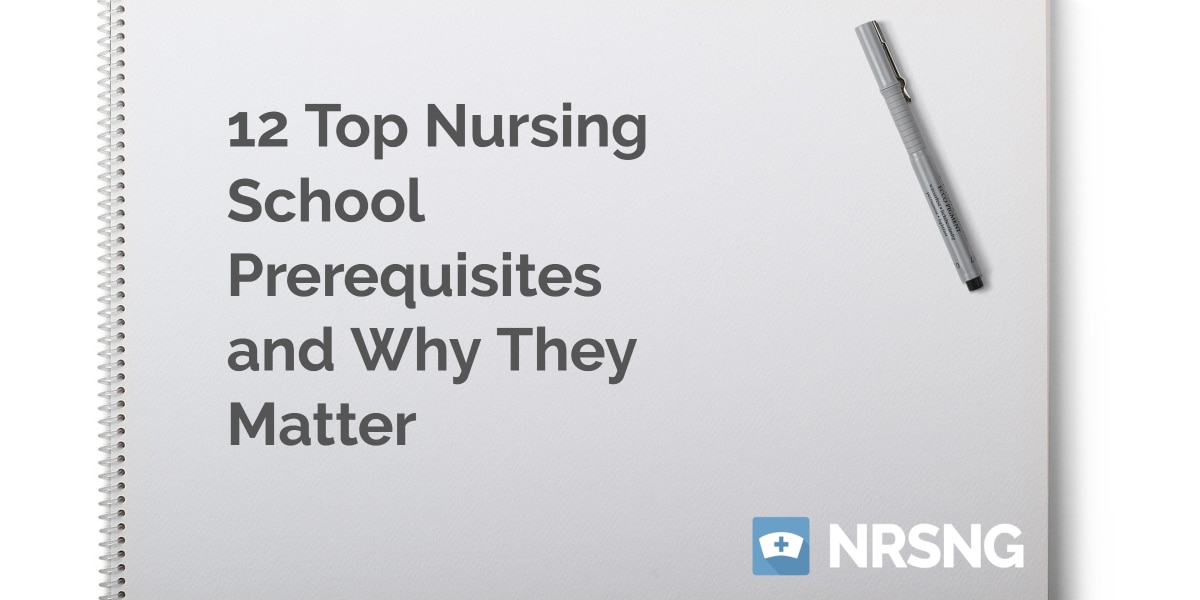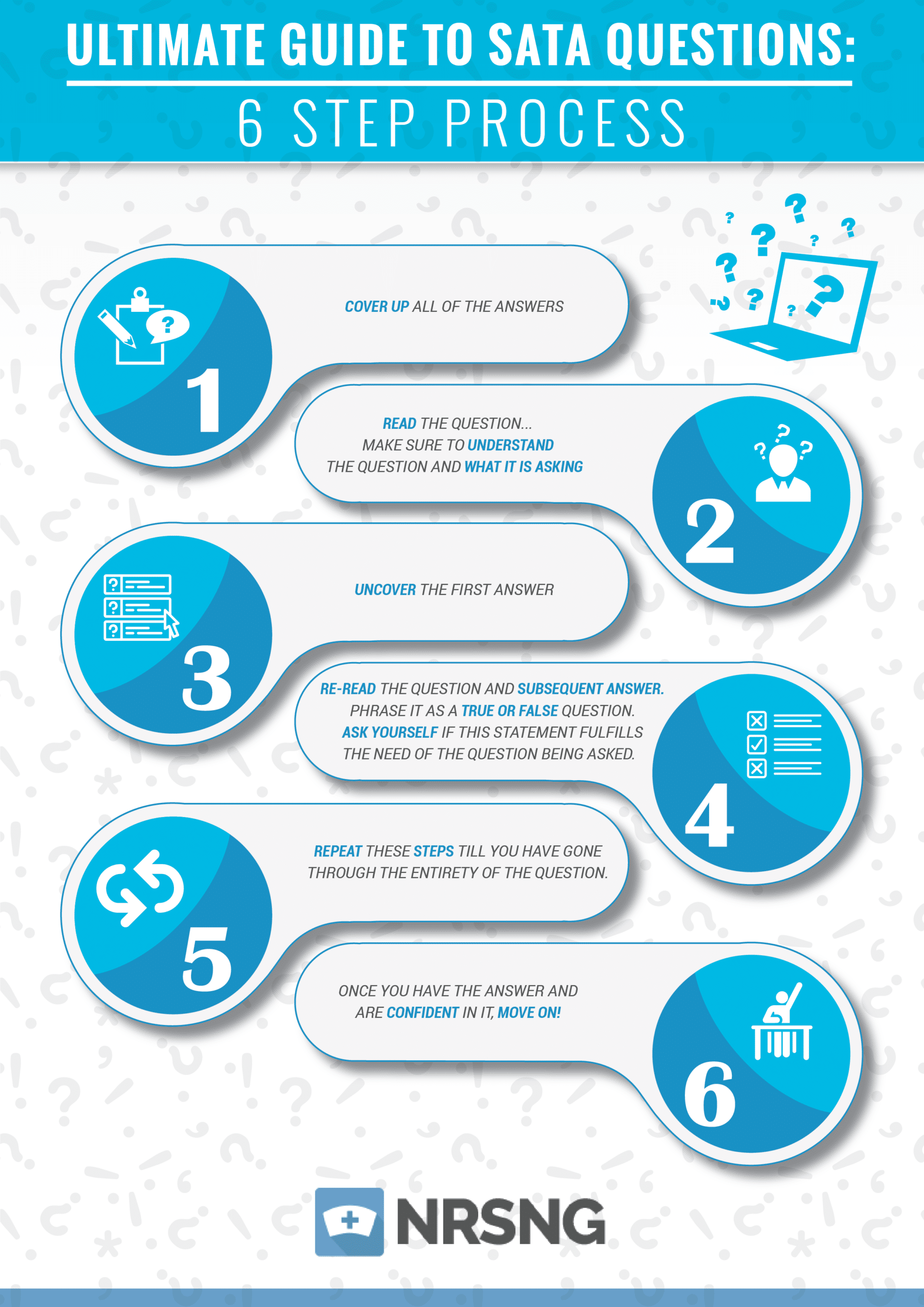The Ultimate Guide to Select All That Apply Questions (how to answer NCLEX questions) | NURSING.com


Ahhh.. the dreaded last words of the nursing student… select all that apply.
When these questions are seen on an exam, they evoke fear, anxiety and the occasional myocardial infarction.
If you’re not sure what I’m talking about when I say “select all that apply,” here is an example:
A patient has been placed on neutropenic precautions and the nurse is preparing the room. Which of the following needs to be implemented?
- a) Vaccinate the patient for Measles
- b) Get rid of all plants
- c) Increase vegetables in the diet
- d) Wash fruits very thoroughly
- e) Have the patient wear a mask only when leaving the room.
Answer: B, E
(To simplify, I’m going to refer to select all that apply questions as SATA from here on out.)
These questions seem like a normal questions at first glance, however, they are very different and difficult. At NURSING.com, we realize how big of an issue SATA is during nursing school and the NCLEX. So much so, that we’ve created this resource blog post as well as an amazing NCLEX simulation app called SIMCLEX™, which simulates the NCLEX algorithms. it’s actually part of our NURSING.com program which you can find at NURSING.com.
SATA has always been really frustrating for me and many fellow nurses and nursing students. But why? Why do we hate SATA with all that we are… with the very essence of our being?
Let’s discuss…
Defining the Struggle
Whenever I would see one of these questions come up on any exams in school, I would attempt to look at it like I looked at all other questions. I quickly found myself frustrated and overwhelmed, as it took much longer than other multiple choice questions, and required more thought and time. Oh, and the stakes are higher. You have to select all of the correct answers, therefore, if you miss one, you miss the whole problem.
For example…
A 45-year-old heroin overdose patient has been pushed out of a car at the entrance of the emergency room while the getaway car squealed off. You get this patient on a stretcher and roll them into the resuscitation bay, not breathing, pale, but with a pulse. Which of the following should the nurse prepare for this patient?
- a) Oxygen bag-valve-mask
- b) Narcan
- c) Suction
- d) Intubation box
- e) Romazicon
- f) Thermometer
- g) Crash cart
- h) Rapid infuser
Answer: A, B, C, D, G
This can be pretty overwhelming, especially to a newer nursing student just getting used to these exams. I would be happy to just to get one of the 6 different options correct, let alone all of them. I would get so frustrated and overwhelmed that I would just check out entirely, make a guess, and pray.
Mentally check out. Guess. Pray.
Mentally check out. Guess. Pray.
This is a terrible idea, guys. Terrible.
I frequently found myself counting the number of SATA questions on the exam and just assumed I’d get all of them wrong, then I’d calculate what I thought my grade would be.
I think we get anxious when we see these questions, have negative and self-defeating thought processes and quickly get overwhelmed. They become so difficult that it’s a lot easier to just take a stab at it, hope we got it right, and move on, rather than actually systematically working through the question with confidence.
Another pitfall I see is grouping answers together. If you read the question and look at the 4-7 possible answers and think a few look similar and a few look like oddballs and just guess by selecting the similar ones, that again can lead you down the wrong path.
However, one of the biggest things we struggle with when dealing with SATA questions is our own expectations. We look at all questions the same and expect it should take the same amount of time that it takes to work through our other questions and become frustrated when it takes longer. I would look at the question, analyze it the same as the other multiple choices, and quickly become frustrated that it was taking longer. I’d start to feel like I should be able to get this sooner, and just give up because I was too overwhelmed and confused to make sense of it.
When you add all of that together, it can be enough to make you feel like you’ll never get it. And then you start the snowball effect of… “well, if I can’t get these stupid SATA questions, I’ll never pass this exam, or this class, or nursing school… this isn’t for me, I’m not smart enough, and I’ll never make it…”
Sound familiar?
Here at NURSING.com, we understand this pain on a very real level. We were all there… struggling to get through those exams that seemed to have more SATA than anything else. We want to change the mindset… adjust the thought process… give you a set of NURSING.com glasses to view these questions with a new lens.
First, we’re going to make sure we are all on the same page about what SATA really are. Even though they may look like it, they are NOT normal multiple choice questions.
Let me repeat that.
Ahhh.. the dreaded last words of the nursing student… select all that apply.
They are merely disguised as such. They are a wolf in sheep’s clothing, people.
When you see one, we want your mind to go down the same positive and productive pathway each time. Gone will be the days of seeing a SATA, followed by immediate feelings of frustration and being overwhelmed, then defeat, and pretty low self-esteem. This needs to turn into a systematic process of SATA domination.
So let’s go through an explanation of what these questions really are asking and how they are vastly different from the rest of your normal multiple choice questions, followed by a systematic way of tackling them.
Let’s go!
What SATA Really Are
First, let’s talk about the specific NCSBN (you know… the people who write in the NCLEX®) definition of what a SATA is.
Format
According to their website, a SATA is considered an alternate item format question. Here is what it says specifically, copied directly from their site (on Nov. 3, 2016)…
Therefore, your SATA must – by definition – contain at least two answers. You’ll get a question with most likely 4-7 options and you must select all answers that apply to the question they are asking. At least 2 answers that are listed will be correct.
For example,
A nurse is assessing a client. Which of the following signs and symptoms would indicate the patient is in shock?
- A) Pinpoint pupils
- B) Anxiety
- C) Decreased thirst
- D) Increased deep tendon reflexes
- E) Restlessness
Answer: B, E
So remember, by definition, all SATA will contain at least two answers.
And while this wasn’t found on the NCSBN website, it is common knowledge that even though all answers can be applicable or correct, it is somewhat rare for that to be the case. Please keep that in mind.
If you’re liking these example SATA questions, we have created a great database of practice questions within our NRSNG Academy, which is available at nrsng.com/academy, so you can practice as much as you need to.
How SATA Differ From Multiple Choice
Nursing school multiple choice questions are very different from regular ones. In nursing school, you’ll get a question and four multiple-choice options. In most classes, one of the four options will be correct and the other three options will be incorrect. However, in nursing school, all four options will most likely be correct. Your task is to figure out which option is the most correct.
Confused yet?
It’s not as black and white as one would assume. The only questions in nursing school that are black and white are true and false questions.
If true and false questions are black and white, then multiple choice questions are all different shades of grey. Your task is to figure out which option is the darkest grey.
So whenever you see a true or false question, you know that one option will be true and one will be false… therefore, one answer is correct and one is not. It is very black and white.

The trick to understanding SATA questions is to know that they are essential 5-7 true or false questions rolled into one. You’ll look at the question you’re given and all options as separate true or false questions (we’ll go through the actual process later).
So to review…
- SATA questions are black and white.
- SATA questions are several true or false questions all rolled into one.
And…
- Multiple choice questions are grey.
- Multiple choice questions are figuring out which option is the most correct or applicable.
You must differentiate multiple choice and SATA in your mind right this very second! Knowing these are two totally different kinds of questions is essential to understanding them.
How to Mentally Process SATA Questions
Now that we’re on the same page about the format and definition of SATA, let’s dig deeper into how we should view them. I am here to dispel a myth: that all exam questions are created equal. They are not.
Again, SATA questions are not your run of the mill multiple choice question and are more like 6 true / false questions wrapped into one. Because of this, they must take longer and more thought to arrive at the correct answer. They should take much longer to answer merely because of their structure.
Therefore, when you’re working through a test, you cannot look at the time it takes to answer a multiple choice question and a SATA and get frustrated if the SATA is taking you much longer. It absolutely take much longer. And if it does take much longer, that means you’re doing something right.
So when you see one of these questions come up, take a deep breath and get comfy. It is going to take some time to get through this bad boy.
If exam questions were car wash options, multiple choice would be the quick exterior wash where you’re done in 3 minutes, and SATA would be the full service with the extra rinse, the fancy soap, tire wash, hand wax, and bottom blaster undercarriage wash (oh my!).
True/false Component
The following is a SATA question that I want you to read, and answer before moving on. Then after you have your answer read on to try to read this question a little differently.
Question:
You’re taking care of a 75-year-old female who is confused and keeps saying, “I need to get home because my husband needs to have dinner prepared for him. He will be scared if I’m not home! I have to get home.” She thinks the year is 1972 (getting angry when you reorient her) and she is convinced that the housekeeper is stealing her cookies. After walking in on her calling 911 to get a ride home, which of the following interventions should be implemented to help keep this client safe? Select all that apply
- A) Placing her in a room by the nurses station
- B) Grabbing the extra cookies in the pantry and giving them to her
- C) Reorienting her to the day and year
- D) Getting a sitter for her to talk to and help distract her from trying to leave
- E) Putting non-slip socks on
Got your answer?
Now let’s approach this a little differently…
Try to answer this question by turning this question into a series of true or false questions…
- A. Does “placing her in a room by the nurses station” help keep this client safe? True or False?
TRUE, It keeps the client from potential danger due to confusion by having people close by.
- B. Does “Grabbing the extra cookies in the pantry and giving them to her” help keep this client safe? True or False?
FALSE, This might be nice but it does not affect the patient’s’ safety.
- C. Does “Reorienting her to the day and year” help keep this client safe? True or False?
FALSE, Under normal circumstances this is a good thing, but it not only upsets the patient, but it also doesn’t address the issue of safety.
- D. Does “Getting a sitter for her to talk to and help distract her from trying to leave” help keep this client safe? True or False?
TRUE, This will certainly help keep the patient safe. But do we need to have a sitter if we moved her? Or should we not move her if we have a sitter? PLEASE TAKE NOTE: This is it’s own question, the prior question of moving the patient does not change the answer to this question even though it is all in one select all that apply question. Keep it separate.
- E. Does “Putting non-slip socks on” help keep this client safe? True or False?
TRUE, Non-slip socks are always a good idea but they also help keep the patient from falling thus keeps the patient safe.
See how we took one question and turned it into 5 smaller ones? If you take a second to break it up and ask yourself directly, “is this statement true or false?” it enables you to focus solely on each option, rather than getting confused and distracted by the other options. This method will force you to focus on answering the specific question being asked.
You know how when you’re watching a presidential debate and a very specific question is asked, and the candidate takes their entire 2 minutes answering a different question, rather than answering the question at hand? That’s kind of what we can do to ourselves when we get these huge questions with a ton of options. We see all of this information and it’s very easy to get distracted, create little thought-process rabbit holes that may have some merit, but they’re not answering the question that was asked.
Going back to that previous example… getting her cookies sounds like it would work to calm her down, but does that address the question being asked about safety most directly? No, it does not.
We have to force ourselves to directly focus on answering the question at hand when we look at each option individually.
If you work through all your select all that apply questions like this you can help break them down.
Don’t measure your pace
It was inevitable that at some point early on while taking the test, someone would go up to hand in their test and walk out. The first thing I would always do is look at the number I was on and panic because I was only on question 3 and they were completely done.
DO NOT DO THIS TO YOURSELF.
It means nothing. I hated when people would say, “They probably didn’t study and got them all wrong.” because some of the people I studied with would be the first to hand in their tests and I knew they studied (and we shared our test scores too so I know they didn’t get them all wrong).
I want to pause and give you a moment to think about something. I am an ER nurse. I have to think quickly and know the answers quickly. I was ALWAYS the last person to hand in my test. The teacher would be hovering over me, waiting for my test and I would just be getting to the last page of the test. I know from first-hand experience that you can still pass nursing school, pass the NCLEX, and make it as a nurse despite taking longer to answer nursing test questions. It means nothing.
If you feel like SATA questions take you too long to answer, it’s because you are comparing one multiple choice question to one select all that apply question. But really they are multiple questions in one select all that apply.
So if you have 6 test questions but one of them is a SATA with 5 options, you really have 10 total test questions.
They just do not compare. You have to think about them in another light. You have to let go of what you thought was one question and start rethinking of it as a little chest of questions that you open and sort through.
Before we get ahead of ourselves, let me explain that select all that apply (SATA) questions are terrifying. You are not alone in this feeling. This overwhelming fear can be paralyzing, causing you to not think clearly. That is why practicing for these questions is key. We have compiled a few steps to help you navigate through the jungle that a SATA question can be.
To start with, I want you to get in the proper mindset during any exam by tuning everyone else around you.
Imagine that you are the only person in the room.
Just you, your knowledge, your pen/pencil, and the test.
Once you come to a SATA question, freak out!
Just kidding.
I want you to calm down, breathe easy and follow the following steps:
- Cover up all of the answers
- Read the question… make sure to understand the question and what it is asking
- Uncover the first answer
- Re-read the question and subsequent answer. Phrase it as a true or false question. Ask yourself if this statement fulfills the need of the question being asked.
- Repeat these steps till you have gone through the entirety of the question.
NOTE: If while you’re working through the questions, you remember something important that may change a previous answer, continue working through until you finish, and then go back and start over. Do not go back in the middle; wait until you have finished answering all options, and then go back and reevaluate.
- Once you have the answer and are confident in it, move on!

Select all that apply questions are NOT like regular nursing multiple choice questions. Thus, it will take longer for you to answer these questions. The stakes are higher because you have to get them all right to get the question right. It was a source of frustration for me because it would majorly slow down my rhythm I was taking my test in, but these questions are not the same.
Remember that! Change your expectations for pace when you come to an SATA question. Slow down. Breathe. SATA are a bunch of questions all rolled into one.
We have quite a few resources available to help you practice these questions as much as you’d like, wherever you’d like. We have our Nursing Practice Questions Database, as well as our SIMCLEX which actually simulates the NCLEX. These resources are available as part of NURSING.com.
So, think of these questions like baking. We use ingredients to make cookies, brownies, bread, etc. You start baking cookies, specifically chocolate chip cookies. The ingredients go together in a particular order that you read on the back of the bag of chocolate chips. You mix it up, put it in the oven and wait the longest 9 minutes of your life for them to bake. You move on to brownies which is incrementally harder because of the wait time increased to 30+ minutes. Eventually you start to make cakes from scratch and this is kinda where we start nursing school.
Nursing school is similar to cupcake wars where they tell you to make cupcakes out of artichokes and tulips and you are left thinking you don’t even want to taste them.
Of course, though, just when you have practiced long enough to finally make that vegan cucumber ghost pepper cupcake from scratch, they throw in the SATA souffle where you are trying to trap air bubbles just right and bake the proteins to hold the shape and wait…what???? I thought we were baking… If your first souffle was as failed as mine, then welcome to the club. In fact, if you are reading this post, you have likely already failed at your first SATA souffle and now would like to be the next Buddy Valastro.
I can’t promise you a TV show on Food Network, but I would like you to get that souffle down to a science. You can’t rush a souffle, you cannot take shortcuts, you must roll up your sleeves, put your ‘kiss the cook’ apron on and pray for the patience to carefully craft the most difficult mind-blowing dessert to bake.
Remember, when you have reached a SATA question on the NCLEX, you are proving that you are better than brownies.
The 4 commandments of Select All That Apply Questions
You have studied, followed the words of your professors, and read the holy nursing bible.
You went to all the sermons and have tirelessly been a faithful disciple.
So it is no surprise to you that when the Select All That Apply (SATA) devil shows up, you turn to prayer.
But just as you think nobody is hearing your prayers, the NRSNG team comes down from Mount Sinai holding the 4 commandments of SATA.
"You rejoice, knowing that you will follow these commandments every time you answer a SATA question and will now know the way."
Click to Tweet
Select All That Apply Commandments

Commandment 1: Honor thy Truth and thy False as this will get you to the answer of SATA.
You need to look at the SATA question as a series of true or false questions. The best way to do this is to take each option and phrase it like a true or false question and if it is true, then you select it as an answer.
Commandment 2: Thou shall not commit question adultery while answering a SATA question.
You already know that SATA are multiple questions in one so take it one line at a time, one true or false question at a time. This is pretty key here because you can really build a maze of rabbit holes on yourself if you play the ‘if this than that’ game. Not only will this cause you to think LONGER than needed but you will probably get the question wrong.
RELATED ARTICLE: How to Dissect an NCLEX® Question
Commandment 3: Remember the NCLEX day, keep it holy, know that getting SATA is not your undoing but rather a symbol of hope that you are doing well on the NCLEX.
You may not realize this, but you really want SATA questions because this symbolizes that you are playing in the big leagues now. My father always taught me to practice shooting the basketball as though there was a defender in front of me all the time so that when I was playing in the game I was able to make the shot. Taking the NCLEX is similar, practice for the NCLEX as though you are going to be blocked, get the skills to maneuver past the defender that is the SATA question that is trying to stop you from winning the game. Do not accept defeat, practice for the win.

Commandment 4: You shall not have any other NCLEX, for I, the NCLEX, your NCLEX, am a jealous NCLEX.
Wishing you could have another NCLEX is not going to save you. Embrace our holy NCLEX as this is the only way to Nurse-dome. Literally… No.Other.Way. So practice, practice, practice and rejoice when you come across a SATA question on the NCLEX. Look that SATA, point your staff to part the SATA sea into T/F questions, then as you walk through the Red SATA sea, you collapse those walls of water down behind you, do not look back!
From experience I can tell you that playing the Hail Mary card is like running into a fight without your gear on (AKA a bad idea) , so I propose instead that you draw your sword-o-knowledge from your scabbard-skull and SLAY in the name of nursing students everywhere!
SATA Questions the Bane of Your Existence? (Learn How to Dominate Select all that apply NCLEX Questions)
The SATA question is a struggle for a lot of nursing students. You may have had very little or no exposure to them prior to nursing school. It requires
a thorough knowledge of the question being asked. We can help you know how to answer all those select all that apply NCLEX questions in this podcast!


.png?width=50&height=50&name=image%20(11).png)





